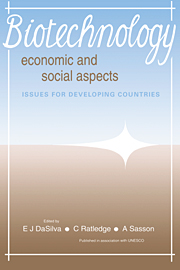Book contents
- Frontmatter
- Contents
- List of contributors
- Preface
- 1 Biotechnology: the socio-economic revolution? A synoptic view of the world status of biotechnology
- 2 Bioethanol production: economic and social considerations in failures and successes
- 3 Biofertilizers: agronomic and environmental impacts and economics
- 4 Microalgal biotechnology: is it an economic success?
- 5 Production of useful biochemicals by higher-plant cell cultures: biotechnological and economic aspects
- 6 Mushroom production – an economic measure in maintenance of food security
- 7 The economic viability of Single Cell Protein (SCP) production in the twenty-first century
- 8 The impact of biotechnology on international commodity trade
- 9 Biotechnology: socio-economic considerations, intercultural perspectives and international viewpoints
- 10 Joint microbial biotechnological ventures in developing countries: social promises and economic considerations
- 11 The economic and social implications of gene technology to developing countries
- 12 Making biotechnology appropriate – and environmentally sound
- 13 Information support for research and development in biotechnological applications
- 14 The effects of emerging biotechnologies on plant and animal agriculture – a viewpoint
- Index
8 - The impact of biotechnology on international commodity trade
Published online by Cambridge University Press: 04 August 2010
- Frontmatter
- Contents
- List of contributors
- Preface
- 1 Biotechnology: the socio-economic revolution? A synoptic view of the world status of biotechnology
- 2 Bioethanol production: economic and social considerations in failures and successes
- 3 Biofertilizers: agronomic and environmental impacts and economics
- 4 Microalgal biotechnology: is it an economic success?
- 5 Production of useful biochemicals by higher-plant cell cultures: biotechnological and economic aspects
- 6 Mushroom production – an economic measure in maintenance of food security
- 7 The economic viability of Single Cell Protein (SCP) production in the twenty-first century
- 8 The impact of biotechnology on international commodity trade
- 9 Biotechnology: socio-economic considerations, intercultural perspectives and international viewpoints
- 10 Joint microbial biotechnological ventures in developing countries: social promises and economic considerations
- 11 The economic and social implications of gene technology to developing countries
- 12 Making biotechnology appropriate – and environmentally sound
- 13 Information support for research and development in biotechnological applications
- 14 The effects of emerging biotechnologies on plant and animal agriculture – a viewpoint
- Index
Summary
Introduction
Commodity prices are set to decline overall in the 1990s. Biotechnology ‘is quite certainly called upon to act as a further factor reducing the overall demand for primary products from developing countries’ (OECD, 1989). The introduction of new technologies has always led to shifts in the international division of labour. New products replace old ones. New production processes make the production of specific goods cheaper in one region than in another often leading to shifts in world supply. Although it may not be as revolutionary as other new technologies (Buttel, 1989), biotechnology is no exception. It is expected to have a considerable impact on world trade.
Replacement of commodities as a result of the introduction of new technologies is not a new phenomenon. It has occurred again and again in history. Cases in point are the replacement of indigo and other pigments by colours produced petrochemically, the replacement of natural fibres (especially sisal) by synthetic fibres and the competition between natural rubber and synthetic rubber. Nevertheless the present situation may differ significantly from historical experience in that (1) switches to a new raw material base may actually take place much quicker than in the past, (2) a large number of commodities will undergo major changes in supply and demand simultaneously, and (3) alternative sources for foreign exchange earnings may be more limited now than in the past (Junne, 1987a; Junne, Komen & Tomeï, 1989). The present contribution discusses different types of substitution processes and their impact on trade.
- Type
- Chapter
- Information
- Biotechnology: Economic and Social AspectsIssues for Developing Countries, pp. 165 - 188Publisher: Cambridge University PressPrint publication year: 1992

